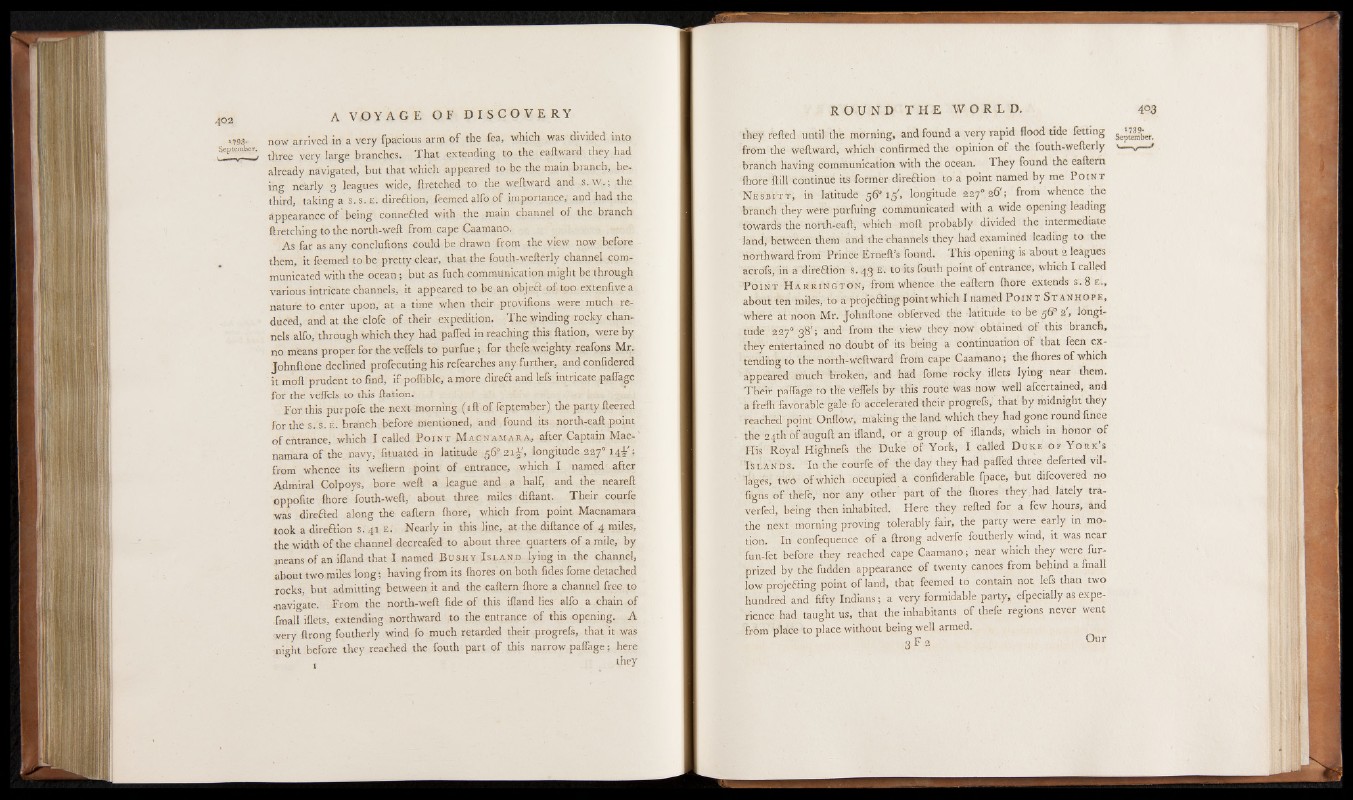
>793- now arrived in a very fpacious arm o f the fea, which was divided into
September', three very large branches. That extending to the eaftward they had
already navigated, but that which appeared to be the main branch, be.,
ing nearly 3 leagues wide, ftretched to the weftward and s .w .; the
third, taking a s. s.E. direftion, feemed alfo of importance, and had the
appearance o f being connefted with the mam channel of the branch
ftretching to the north-well from cape Caamano.
As far as any conclufions could be drawn frorp the view now before
them, it feemed to be pretty clear, that the fouth-wefterly channel communicated
with the ocean; but as fuch communication might be through
various intricate channels, it appeared to be an object of too extenlive a
nature to enter upon, at a time when their provifions were much reduced,
and at the clofe of their expedition. The winding rocky channels
alfo, through which they had palled in reaching this llation, were by
no means proper for the velfels to purfue ; for thefe weighty reafons Mr.
Johnftone declined profecuting his refearches any further, and confidered
it moll prudent to find, if poffible, a more direft and left intricate paflage
for the veflels to this llation.
For this purpofe the next morning ( ill of feptember) the party fleered
for the s.s.E. branch before mentioned, and found its north-eaft point
of entrance, which I called P o i n t M a c n a m a r a , after Captain Mac-'
namara of the navy, fituated in latitude 56? 21-5, longitude 227014 !';
from whence its wellern point o f entrance, which I named after
Admiral Colpoys, bore weft a league and a half, and the neareft
oppofite Ihore fouth-weft, about three miles diftant. Their courfe
was direfted along the eaftern Ihore, which from point Macnamara
took a direftion s.41 e . Nearly in this line, at the diftance o f 4 miles,
the width of the channel decreafed to about three quarters o f a mile, by
jneans of an ifiand that I named B u s h y I s l a n d lying in the channel,
about two miles long; having from its Ihores on both fides fome detached
rocks, but admitting between it and the eaftern Ihore a channel free to
•navigate. From the north-weft fide o f this illand lies alfo a chain of
fmall iflets, extending northward to the entrance of this opening. A
very ftrong foutherly wind fo much retarded their progrefs, that it was
night before they reached the fouth part o f this narrow paflage; here
x they
they relied until the morning, and found a very rapid flood tide fetting
from the weftward, which confirmed the opinion of the fouth-wefterly ' v ^
branch having communication with the ocean. They found the eaftern
Ihore Hill continue its former direftion to a point named by me P o i n t
N e s b i t t , in latitude 56“ 15', longitude 227° 26'; from whence the
branch they were purfuing communicated with a wide opening leading
towards the north-eaft, which moll probably divided the intermediate
land, between them and the channels they had examined leading to the
northward from Prince Erneft’s found. This opening is about 2 leagues
acroft, in a direftion s. 43 e. to its fouth point of entrance, which I called
P o i n t H a r r i n g t o n , from whence the eaftern Ihore extends s. 8 £.,
about ten miles, to a projefting point which I named P o i n t S t a n h o p e ,
where at noon Mr. Johnftone obferved the latitude £0 be 56° 2', longitude
2270 38'; and from the view they now obtained of this branch,
they entertained no doubt of its being a continuation of that leen extending
to the north-weftward from cape Caamano; the Ihores of which
appeared much broken, and had fome rocky iflets lying near them.
Their paflage to the velfels by this route was now well afcertained, and
a frelh favorable gale fo accelerated their progrefs, that by midnight they
reached point Onflow, making the land which they had gone round fince
the-24th of auguft an illand, or a group of illands, which in honor o f
His Royal Highnefs the Duke of York, I called D u k e o f Y o r k ’s
I s l a n d s . In the courle o f the day they had pafled three delerted villages,
two of which occupied a confiderable fpace, but difcovered no
ftgns of thefe, nor any other' part of the Ihores they had lately tra-
verfed, being then inhabited. Here they relied for a few hours, and
the next morning proving tolerably fair, the party were early in motion.
In confequence of a ftrong adverfe foutherly wind, it was near
fun-let before they reached cape Caamano; near which they were fur-
prized by the fudden appearance of twenty canoes from behind a fmall
low projefting point of land, that feemed to contain not left than two
hundred and fifty Indians; a very formidable party, efpecially as experience
had taught us, that the inhabitants of thefe regions never went
from place to place without being well armed.
Our